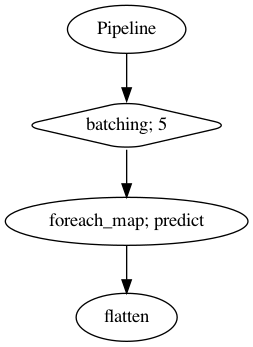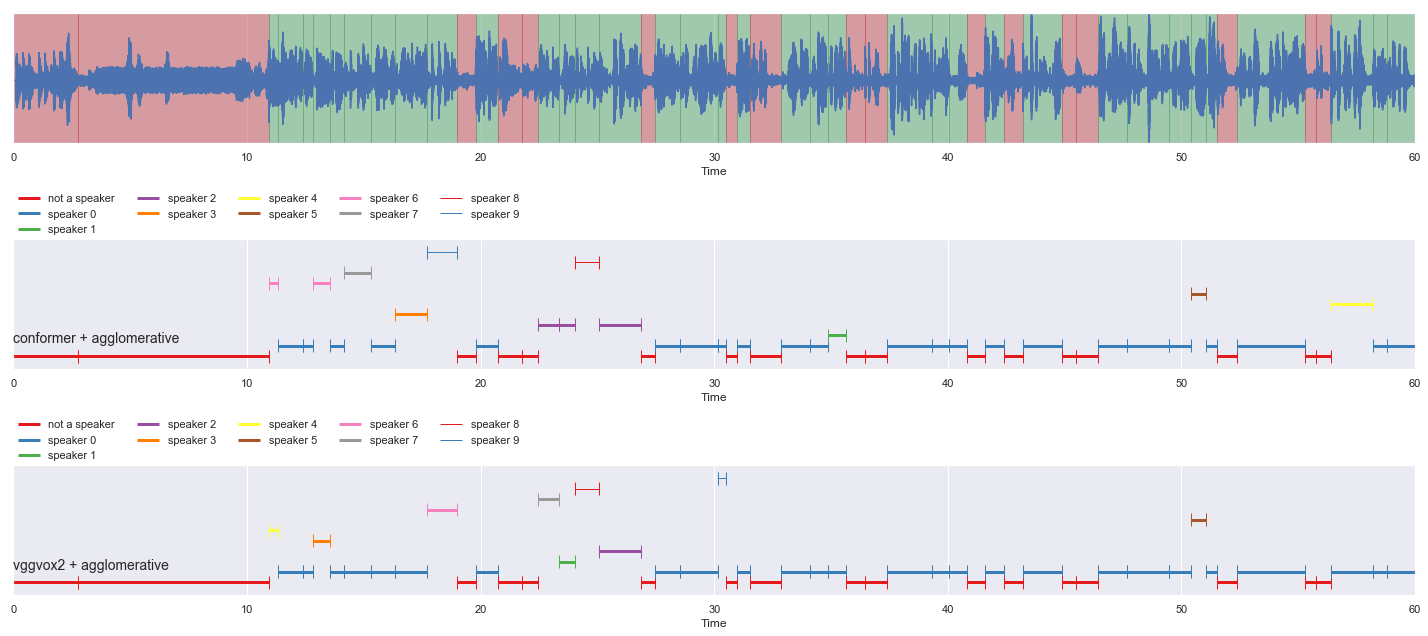Unsupervised clustering using Agglomerative
Contents
Unsupervised clustering using Agglomerative#
This tutorial is available as an IPython notebook at malaya-speech/example/diarization-clustering-agglomerative.
This module is language independent, so it save to use on different languages. Pretrained models trained on multilanguages.
This is an application of malaya-speech Pipeline, read more about malaya-speech Pipeline at malaya-speech/example/pipeline.
[1]:
from malaya_speech import Pipeline
import malaya_speech
import numpy as np
import matplotlib.pyplot as plt
load Speaker Vector#
So to know speakers similarity, we can use speaker vector, just load using malaya_speech.speaker_vector.deep_model. Read more about malaya-speech Speaker Vector at https://malaya-speech.readthedocs.io/en/latest/load-speaker-vector.html
We are going to compare conformer-base and vggvox-v2.
[2]:
model_conformer = malaya_speech.speaker_vector.deep_model('conformer-base')
model_vggvox2 = malaya_speech.speaker_vector.deep_model('vggvox-v2')
Load audio sample#
[3]:
y, sr = malaya_speech.load('speech/video/The-Singaporean-White-Boy.wav')
len(y), sr
[3]:
(1634237, 16000)
[4]:
# just going to take 60 seconds
y = y[:sr * 60]
This audio extracted from https://www.youtube.com/watch?v=HylaY5e1awo&t=2s
Load VAD#
We need to use VAD module to know which parts of the audio sample are speaker activities, read more about VAD at https://malaya-speech.readthedocs.io/en/latest/load-vad.html
[5]:
vad = malaya_speech.vad.deep_model(model = 'vggvox-v2')
[6]:
frames = list(malaya_speech.utils.generator.frames(y, 30, sr))
[7]:
p = Pipeline()
pipeline = (
p.batching(5)
.foreach_map(vad.predict)
.flatten()
)
p.visualize()
[7]:

[8]:
%%time
result = p(frames)
result.keys()
/Library/Frameworks/Python.framework/Versions/3.7/lib/python3.7/site-packages/librosa/core/spectrum.py:224: UserWarning: n_fft=512 is too small for input signal of length=480
n_fft, y.shape[-1]
CPU times: user 1min 1s, sys: 37.2 s, total: 1min 38s
Wall time: 21.7 s
[8]:
dict_keys(['batching', 'predict', 'flatten'])
[9]:
frames_vad = [(frame, result['flatten'][no]) for no, frame in enumerate(frames)]
grouped_vad = malaya_speech.utils.group.group_frames(frames_vad)
grouped_vad = malaya_speech.utils.group.group_frames_threshold(grouped_vad, threshold_to_stop = 0.3)
[10]:
malaya_speech.extra.visualization.visualize_vad(y, grouped_vad, sr, figsize = (15, 3))

Load Agglomerative clustering model#
class AgglomerativeClustering:
def __init__(
self,
min_clusters: int,
max_clusters: int,
metric: str = 'cosine',
threshold: float = 0.25,
method: str = 'centroid',
):
"""
Load malaya-speech AgglomerativeClustering, originallly from pyannote, https://github.com/pyannote/pyannote-audio/blob/develop/pyannote/audio/pipelines/clustering.py
Parameters
----------
min_clusters: int
minimum cluster size, must bigger than 0
max_clusters: int
maximum cluster size, must equal or bigger than `min_clusters`.
if equal to `min_clusters`, will directly fit into HMM without calculating the best cluster size.
metric: str, optional (default='cosine')
Only support `cosine` and `euclidean`.
threshold: float, optional (default=0.35)
minimum threshold to assume current iteration of cluster is the best fit.
method: str, optional (default='centroid')
All available methods at https://docs.scipy.org/doc/scipy/reference/generated/scipy.cluster.hierarchy.linkage.html
"""
To get better results using HMM, set norm_function=None and log_distance_metric=None.
[11]:
from malaya_speech.model.clustering import AgglomerativeClustering
[15]:
agg_model = AgglomerativeClustering(min_clusters = 1, max_clusters = 10)
[16]:
result_diarization_agg_conformer = malaya_speech.diarization.clustering(
vad_results = grouped_vad,
speaker_vector = model_conformer,
model = agg_model,
norm_function = None,
)
result_diarization_agg_conformer[:5]
[16]:
[(<malaya_speech.model.frame.Frame at 0x186493510>, 'not a speaker'),
(<malaya_speech.model.frame.Frame at 0x17e2096d0>, 'not a speaker'),
(<malaya_speech.model.frame.Frame at 0x17e209750>, 'speaker 6'),
(<malaya_speech.model.frame.Frame at 0x17e209410>, 'speaker 0'),
(<malaya_speech.model.frame.Frame at 0x17ef728d0>, 'speaker 0')]
[17]:
result_diarization_agg_vggvox2 = malaya_speech.diarization.clustering(
vad_results = grouped_vad,
speaker_vector = model_vggvox2,
model = agg_model,
norm_function = None,
)
result_diarization_agg_vggvox2[:5]
[17]:
[(<malaya_speech.model.frame.Frame at 0x186493510>, 'not a speaker'),
(<malaya_speech.model.frame.Frame at 0x17e2096d0>, 'not a speaker'),
(<malaya_speech.model.frame.Frame at 0x17e209750>, 'speaker 4'),
(<malaya_speech.model.frame.Frame at 0x17e209410>, 'speaker 0'),
(<malaya_speech.model.frame.Frame at 0x17ef728d0>, 'speaker 0')]
[18]:
nrows = 3
fig, ax = plt.subplots(nrows = nrows, ncols = 1)
fig.set_figwidth(20)
fig.set_figheight(nrows * 3)
malaya_speech.extra.visualization.visualize_vad(y, grouped_vad, sr, ax = ax[0])
malaya_speech.extra.visualization.plot_classification(result_diarization_agg_conformer,
'conformer + agglomerative', ax = ax[1],
x_text = 0.01)
malaya_speech.extra.visualization.plot_classification(result_diarization_agg_vggvox2,
'vggvox2 + agglomerative', ax = ax[2],
x_text = 0.01)
fig.tight_layout()
plt.show()

[ ]:
